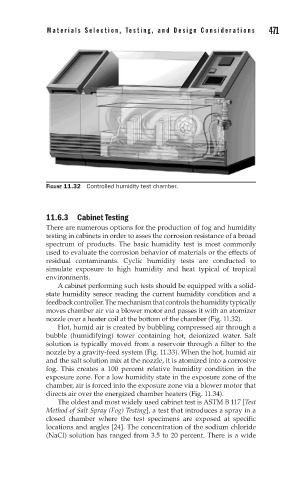Page 504 - Corrosion Engineering Principles and Practice
P. 504
470 C h a p t e r 1 1 M a t e r i a l s S e l e c t i o n , Te s t i n g , a n d D e s i g n C o n s i d e r a t i o n s 471
FIGURE 11.32 Controlled humidity test chamber.
11.6.3 Cabinet Testing
There are numerous options for the production of fog and humidity
testing in cabinets in order to asses the corrosion resistance of a broad
spectrum of products. The basic humidity test is most commonly
used to evaluate the corrosion behavior of materials or the effects of
residual contaminants. Cyclic humidity tests are conducted to
simulate exposure to high humidity and heat typical of tropical
environments.
A cabinet performing such tests should be equipped with a solid-
state humidity sensor reading the current humidity condition and a
feedback controller. The mechanism that controls the humidity typically
moves chamber air via a blower motor and passes it with an atomizer
nozzle over a heater coil at the bottom of the chamber (Fig. 11.32).
Hot, humid air is created by bubbling compressed air through a
bubble (humidifying) tower containing hot, deionized water. Salt
solution is typically moved from a reservoir through a filter to the
nozzle by a gravity-feed system (Fig. 11.33). When the hot, humid air
and the salt solution mix at the nozzle, it is atomized into a corrosive
fog. This creates a 100 percent relative humidity condition in the
exposure zone. For a low humidity state in the exposure zone of the
chamber, air is forced into the exposure zone via a blower motor that
directs air over the energized chamber heaters (Fig. 11.34).
The oldest and most widely used cabinet test is ASTM B 117 [Test
Method of Salt Spray (Fog) Testing], a test that introduces a spray in a
closed chamber where the test specimens are exposed at specific
locations and angles [24]. The concentration of the sodium chloride
(NaCl) solution has ranged from 3.5 to 20 percent. There is a wide

